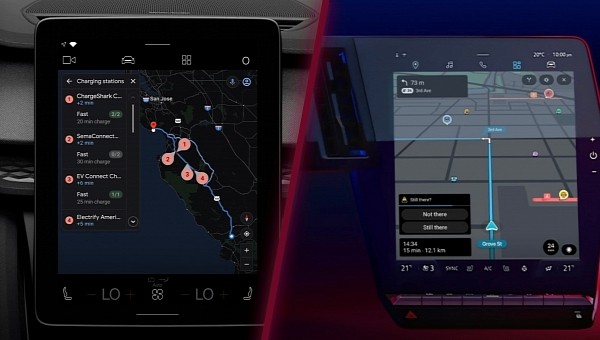It was obviously just a matter of time until Waze made its way to Android Automotive as well, and now that the app is available in the Renault Austral Hybrid and Megane E-Tech, some users might be tempted to give up on Google Maps.
At some level, I feel them, as Waze is by far the better choice for someone who spends most of the time on city roads. Compared to Google Maps, Waze relies on traffic reports to find a faster route to a defined destination, eventually letting you know in advance if you are likely to come across traffic jams, accidents, speed traps, and so on.
Google Maps also offers such warnings, often imported from Waze, but on the other hand, the crowdsourcing engine that powers the traffic reports is the one that makes a huge difference.
As such, Waze missing from Android Automotive has long been a major shortcoming for drivers whose new cars are powered by Google’s platform.
The highly anticipated launch happened not a long time ago, but unfortunately, Waze comes to Android Automotive with quite a lot of limitations.
First and foremost, it’s important to keep in mind that Android Automotive doesn’t require a mobile phone to run, as the operating system is installed on the infotainment system. Despite this, a phone is still required to set up and run Waze, as configuring certain features isn’t possible on Android Automotive.
Setting up Waze in the car starts with users scanning a QR code that shows up in the app installed on Android Automotive. This allows the mobile device to pair with the head unit in the Android Automotive-powered car, therefore establishing the connection that would later power the features that are dependent on the phone.
The first of them is the initial setup itself. Users need to create a Waze account on a phone before being able to log in with the same account on Android Automotive. Creating an account in the car isn’t yet possible.
Then, setting up certain essential Waze features, such as voice navigation, car icons, and moods is something that must take place on the phone as well. Once you finish the configuration, the settings should be transferred to Android Automotive via the Waze account.
If you run Waze on Android Automotive and contribute with traffic information, you’re not going to see any animation when submitting a traffic report. Waze guarantees that you’ll still earn points, but otherwise, no feedback is offered to let you know the report has been submitted successfully.
Android Automotive users also need to configure tolls and HOV passes on the mobile device, as these settings haven’t yet been implemented in the car experience.
All of this makes using Waze less convenient than some Android Automotive users expected, and as such, I wouldn’t be too surprised to see many sticking with Google Maps, at least until a fully featured experience is provided in their cars.
Google Maps also offers such warnings, often imported from Waze, but on the other hand, the crowdsourcing engine that powers the traffic reports is the one that makes a huge difference.
As such, Waze missing from Android Automotive has long been a major shortcoming for drivers whose new cars are powered by Google’s platform.
The highly anticipated launch happened not a long time ago, but unfortunately, Waze comes to Android Automotive with quite a lot of limitations.
First and foremost, it’s important to keep in mind that Android Automotive doesn’t require a mobile phone to run, as the operating system is installed on the infotainment system. Despite this, a phone is still required to set up and run Waze, as configuring certain features isn’t possible on Android Automotive.
Setting up Waze in the car starts with users scanning a QR code that shows up in the app installed on Android Automotive. This allows the mobile device to pair with the head unit in the Android Automotive-powered car, therefore establishing the connection that would later power the features that are dependent on the phone.
The first of them is the initial setup itself. Users need to create a Waze account on a phone before being able to log in with the same account on Android Automotive. Creating an account in the car isn’t yet possible.
Then, setting up certain essential Waze features, such as voice navigation, car icons, and moods is something that must take place on the phone as well. Once you finish the configuration, the settings should be transferred to Android Automotive via the Waze account.
If you run Waze on Android Automotive and contribute with traffic information, you’re not going to see any animation when submitting a traffic report. Waze guarantees that you’ll still earn points, but otherwise, no feedback is offered to let you know the report has been submitted successfully.
Android Automotive users also need to configure tolls and HOV passes on the mobile device, as these settings haven’t yet been implemented in the car experience.
All of this makes using Waze less convenient than some Android Automotive users expected, and as such, I wouldn’t be too surprised to see many sticking with Google Maps, at least until a fully featured experience is provided in their cars.










